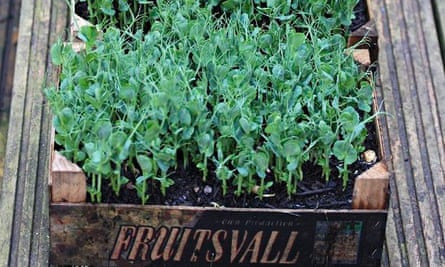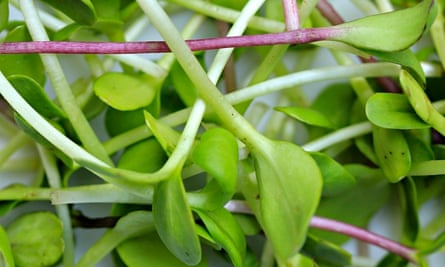If you can find room for a few seed trays by a bright window inside your home you can enjoy shoots and microgreens throughout the winter. Microgreen is the buzzword for leaves harvested small. Salad crops like rocket and pak choi, and herbs like basil and coriander can all be grown as microgreens. Fava bean, broad bean, pea and even popcorn can be eaten small as delicious shoots. And the leaves of some root crops like radish and carrot are tasty and tender when small, extending your choice even further.
Not only are microgreens and shoots one of the quickest and easiest things you can grow, they are also packed with flavour – perfect for livening up winter salads. And, if you follow my tips below, you’ll find that you can grow a surprisingly large amount of them.
How to sow
To get a good yield, sow thickly. As a rule of thumb, the gap between each seed should be the same size as the thickness of the seed you are sowing. There’s no need to spend hours carefully measuring them out. You don’t need to strive for perfect spacing; just make sure you don’t have too many seeds touching each other or bare areas. For larger micro greens, space your seeds further apart. Once you’ve done this, cover your seeds with a light layer of compost about the same depth of the seeds.
Sourcing your seeds
Sowing thickly means you’ll need a lot of seeds. Buying these in conventional seed packs would be hugely expensive. Luckily there are other sources of much lower cost seeds, including:
- Dried seeds and pulses sold for cooking. These include dried peas (look for marrowfat peas), fava beans (trickier to find but Hodmedods will supply mail order), coriander, fenugreek, dill and fennel. As long as they are reasonably fresh, most dried cooking seeds will germinate and grow successfully. You may want to test a few first, just to make sure – very occasionally you’ll find the odd batch that doesn’t.
- Seeds sold in bulk for sprouting are another economical source. I buy my sunflower and radish seeds for shoots from Sky Sprouts in half kilo bags. Half a kilo of seeds will give you many trays of shoots.
- Leftover seeds from unused seed packs that are approaching their use by dates. This is an excellent way to use up any old packs of seeds you have lurking in the back of a cupboard. Basil, dill, carrots, chard, spinach, rocket and cabbage all make excellent microgreens, to name just a few.

Container size
You don’t need a big pot – a cheap plastic seed tray at least one inch deep is all you need to grow shoots and microgreens. You can often find trays for free at market stalls – fruit trays or mushroom trays (lined with newspaper to stop compost falling out of the holes) are perfect.
Compost
While professional growers usually advise on growing microgreens in new compost, I’ve found good results are possible with used compost from your pots. Adding a bit of extra plant food to old compost will help – a handful of worm compost if you have a wormery, or a sprinkling of chicken manure pellets – chicken manure is rich in nitrogen which is what leafy vegetables need most.
Seed soaking
Soaking the seeds overnight or for 24 hours before sowing will speed germination for many crops, but it’s not essential.
Watering
Water the compost lightly before sowing. It needs to be damp but not too wet, rather like a wrung out flannel. You can cover the tray with a plastic bag (or a Perspex lid) after sowing to help retain moisture and speed germination, but again this is not essential. Remove the bag or lid as soon as the seeds germinate. Continue to check the moisture of the compost regularly by putting your finger in it, and water when needed. I use a bottle waterer (a plastic bottle with small holes drilled in the top) for fine watering.

Harvesting
Micro greens grown inside are usually ready to harvest in just two to four weeks (it can be longer in cold weather outside). Most can be harvested at different stages of growth. You can experiment to find the stage you like best – either when the first pair of leaves appear, or later, when a few leaves have grown. One exception is sunflower shoots. These need to be eaten before their second pair of leaves appear, as these are bitter. The easiest way to harvest most microgreens is with a sharp pair of kitchen scissors. Some microgreens – like pea shoots – may regrow, particularly if you chop them just above the lowest leaf. They are also more likely to regrow if grown in a larger pot like a window box.
Six of the best
There’s a huge range of potential microgreens. It’s fun to experiment with everything from the flavour burst of micro coriander or basil, to colourful red cabbage or red amaranth, to more unusual microgreens such as popcorn, chickpeas or shiso.
Here are six of my favourites, which all taste great and are easy to grow:
Pea shoots: these taste like fresh peas. They are good in salads and stir fries, and their pretty tendrils make them an appealing addition to almost any dish.
Fava bean shoots: less well-known than pea shoots, but excellent nevertheless. These have a fresh beany taste, grow easily, and taste good in salads, risottos and stir fries.
Sunflower shoots: have a slightly nutty taste and a pleasing crunch that go particularly well with avocado, but make a super addition to almost any salad.
Rose radish: fast and easy to grow, rose radish shoots will add a pretty red colour to your salads as well as a spicy, peppery kick. I should add, in case its not clear, that unlike radishes grown in the ground, the main part you’ll eat is the leaves (not the root).
Mustards like mizuna, mibuna and mustard red giant: these all pack a spicy punch. Some of them have pretty leaves, too – like mustard red frills.
Coriander: a little slower to germinate, but the intensity of the coriander flavour makes up for the wait. Fantastic as a garnish.
Mark is founder of Vertical Veg, a social enterprise that inspires food growing in small urban spaces. You can get free seasonal tips and a fact sheet on growing food in containers by signing up on the Vertical Veg website.






Comments (…)
Sign in or create your Guardian account to join the discussion